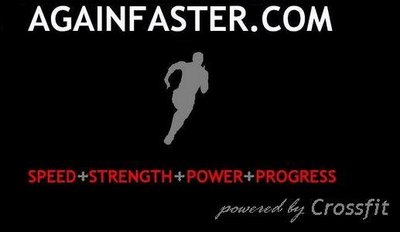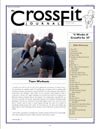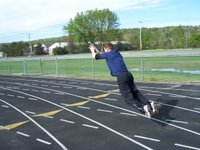Mobile One

I ignored flexibility for a long, long time. I didn't stretch, and I didn't think I had to, because I listened to the experts who said it wasn't necessary.
There is a lot of disagreement in the athletic community over the merits of enhanced flexibility. Two seemingly incompatible facts that all sides seem to agree on:
1.) Static stretching pre-exercise weakens the muscle's ability to produce force.
2.) Moving weight through an increased range of motion requires more work, leading to increased strength and power development.
If static stretching reduces my strength, I shouldn't do it. If I need to develop an increased range of motion to produce more power, I need to stretch. What's an athlete to do?
The answer: dynamic stretching and mobility drills. These are not your typical sit-on-your-butt-and-reach-for-your-toes exercises. They are intended to move your muscles and joints through their entire range of motion. You will reclaim a lot of the flexibility and mobility that life has taken away, without the weakening effects of static stretching.
There is a time and place for reducing the power-generating ability of a muscle through static stretching. When you have a muscle imbalance, such as the hamstring/quad imbalance often seen in distance runners, it makes sense to stretch the stronger muscle (the quad) pre-exercise. This brings the agonist and antagonist muscles into balance.
Dynamic stretching is stretching while moving. The feet are not still, and you're standing. This is much more natural than static stretching--you're essentially practicing the skill of moving your body through it's natural range of motion, rather than forcing your body to contort unnaturally. We often do these drills at Crossfit Boston to loosen up the legs, arms, hips, and shoulders prior to the WOD.
High-knees: The athlete runs in place, bringing the knees as high as possible on each stride. The ball of the foot makes contact with the ground. The arms pump in opposition to the legs, pulling backward with every stride. This exercise enhances mobility in the hips, knees, shoulders, and ankles, and flexibility in the hamstrings and quads.
Butt kicks: Similar to high-knees, the athlete leans forward slightly, attempting to hit him/herself in the butt with the ankle on each stride. Arms pull backward. This stresses the hamstrings, and works all the same joints listed above.
Horizontal skip: The athlete attempts to launch him/herself as far as possible across the floor, generating power by pushing the knee upward and outward, while throwing the opposite arm outward at a 45 degree angle. Upon landing, the other arm/leg combination is used. The horizontal skip stresses the glutes and calves, and helps develop explosive power and coordination.
Vertical skip: This time, the athlete is trying to get as high as possible with each leap. Instead of the knee and opposite arm projecting at a 45 degree angle, both are launched straight up. Again, we're stressing the major movers of the leg, along with the calves. Every major joint is engaged throughout this exercise.
Grapevine: This exercise stresses hip rotation without excessive rotation of the lower back, teaching the athlete to move the pelvis independently of the spine. This skill is critical for power generation during rotational movements such as pulling and throwing.
The athlete turns perpendicular to the direction of travel, feet parallel. The rear foot crosses in front of the front foot, and plants. The other foot steps back out to parallel, and plants. The rear foot then steps behind the front foot and plants, and the crossed foot steps to parallel. The hips rotate during the sequence, but the torso remains perpendicular to the direction of travel. This exercise is done facing both directions.
Broad jump: The athlete starts with his/her feet parallel and shoulder-width. The butt sinks back, the knees bend, and the arms are loaded backward. The athlete projects forward at a 45 degree angle, extending the knees, hips, and arms. Mid-flight, the knees are tucked under as the athlete prepares to land, feet parallel and shoulder-width.
The broad jump requires tremendous coordination and develops explosive ability throughout the hips and legs. It enhances flexibility in the hips, quads, hamstrings, and glutes.
Joint mobility exercises are aimed at enhancing the rotational range of the joint by breaking down barriers to movement--calcifications, connective tissue misalignment, and fluid build-up. I've recently done some joint mobility work with Mandla Nkosi at Boston Kettlebell, and the results have been great. Some of the drills I've learned:
Hips: The pelvis is moved through its entire range of motion, tilted anteriorly, moved leftward, tilted posteriorly, and moved rightward. The rotation is then reversed. Moving the pelvis independently of the spine is critical to proper technique in the squat, the highpull, and the kettlebell swing.
Knees: The knees are moved through a full 360 degree arc, with the hands placed on the lower thigh. As the knees loosen, the athlete gradually sinks downward, maintaining the range of motion. The feet move along with the knees, ensuring that the knee is activated instead of the ankle. To accomplish this, the athlete pronates and supinates the feet in sync with the knee rotation.
Shoulders: The arms are rotated forward and backward, either together or in opposite directions. The athlete exaggerates the movement to obtain maximum benefit.
Lunge switches: Assuming a front-lunge position, the athlete moves between a left-foot-forward and a right-foot-foward stance by rotating on the balls of the feet. Ideally, the butt stays at the same level throughout the lunges and transitions, and the back stays at this level or below. This exercise works the hip joints, the knees, and the pelvic floor.
Mobility drills can be applied to every joint, including the head and neck and the elbows. I'm still exploring the discipline. That said, I've found that mobility drills have given me greater range of motion in my squats in a very short period of time.
If you're a Crossfitter, you know that squatting is the foundation of all the Olympic lifts and their subparts, as well as a critical component of many metabolic workouts. Enhancing squat depth will allow you to derive increased benefit from every squat you do, in terms of strength, power, and metabolic development.
I used to believe that the squat would take care of itself, given enough time and dedication. Seeing the results I've gotten from joint mobility in the span of two weeks, I've decided that a little help never hurt anybody.
If you find that your range of motion is not adequate to perform squats correctly (ass-to-ankles, lordotic arch maintained, torso vertical, weight on the heels), it's time to consider dynamic stretching and joint mobility as concrete solutions. Many of the athletes I work with would benefit from this training.
Mandla Nkosi offers joint mobility training at the Crossfit Boston facility at very reasonable rates--the athletic payoff is worth the 7 Frappucinos it'll cost you to participate.
I ponied up, and the time-to-maturity of my squat has been greatly reduced as a result.
If you'd like a more in-depth explanation of any of the movements in this article, shoot me an email, or stop by the Facility. You can always join us on Sundays at the Again Faster Workout Series, although I can't guarantee you'll have much time for mobility!
Go faster!
Photo from www.eliteathletetraining.com

I ignored flexibility for a long, long time. I didn't stretch, and I didn't think I had to, because I listened to the experts who said it wasn't necessary.
There is a lot of disagreement in the athletic community over the merits of enhanced flexibility. Two seemingly incompatible facts that all sides seem to agree on:
1.) Static stretching pre-exercise weakens the muscle's ability to produce force.
2.) Moving weight through an increased range of motion requires more work, leading to increased strength and power development.
If static stretching reduces my strength, I shouldn't do it. If I need to develop an increased range of motion to produce more power, I need to stretch. What's an athlete to do?
The answer: dynamic stretching and mobility drills. These are not your typical sit-on-your-butt-and-reach-for-your-toes exercises. They are intended to move your muscles and joints through their entire range of motion. You will reclaim a lot of the flexibility and mobility that life has taken away, without the weakening effects of static stretching.
There is a time and place for reducing the power-generating ability of a muscle through static stretching. When you have a muscle imbalance, such as the hamstring/quad imbalance often seen in distance runners, it makes sense to stretch the stronger muscle (the quad) pre-exercise. This brings the agonist and antagonist muscles into balance.
Dynamic stretching is stretching while moving. The feet are not still, and you're standing. This is much more natural than static stretching--you're essentially practicing the skill of moving your body through it's natural range of motion, rather than forcing your body to contort unnaturally. We often do these drills at Crossfit Boston to loosen up the legs, arms, hips, and shoulders prior to the WOD.
High-knees: The athlete runs in place, bringing the knees as high as possible on each stride. The ball of the foot makes contact with the ground. The arms pump in opposition to the legs, pulling backward with every stride. This exercise enhances mobility in the hips, knees, shoulders, and ankles, and flexibility in the hamstrings and quads.
Butt kicks: Similar to high-knees, the athlete leans forward slightly, attempting to hit him/herself in the butt with the ankle on each stride. Arms pull backward. This stresses the hamstrings, and works all the same joints listed above.
Horizontal skip: The athlete attempts to launch him/herself as far as possible across the floor, generating power by pushing the knee upward and outward, while throwing the opposite arm outward at a 45 degree angle. Upon landing, the other arm/leg combination is used. The horizontal skip stresses the glutes and calves, and helps develop explosive power and coordination.
Vertical skip: This time, the athlete is trying to get as high as possible with each leap. Instead of the knee and opposite arm projecting at a 45 degree angle, both are launched straight up. Again, we're stressing the major movers of the leg, along with the calves. Every major joint is engaged throughout this exercise.
Grapevine: This exercise stresses hip rotation without excessive rotation of the lower back, teaching the athlete to move the pelvis independently of the spine. This skill is critical for power generation during rotational movements such as pulling and throwing.
The athlete turns perpendicular to the direction of travel, feet parallel. The rear foot crosses in front of the front foot, and plants. The other foot steps back out to parallel, and plants. The rear foot then steps behind the front foot and plants, and the crossed foot steps to parallel. The hips rotate during the sequence, but the torso remains perpendicular to the direction of travel. This exercise is done facing both directions.
Broad jump: The athlete starts with his/her feet parallel and shoulder-width. The butt sinks back, the knees bend, and the arms are loaded backward. The athlete projects forward at a 45 degree angle, extending the knees, hips, and arms. Mid-flight, the knees are tucked under as the athlete prepares to land, feet parallel and shoulder-width.
The broad jump requires tremendous coordination and develops explosive ability throughout the hips and legs. It enhances flexibility in the hips, quads, hamstrings, and glutes.
Joint mobility exercises are aimed at enhancing the rotational range of the joint by breaking down barriers to movement--calcifications, connective tissue misalignment, and fluid build-up. I've recently done some joint mobility work with Mandla Nkosi at Boston Kettlebell, and the results have been great. Some of the drills I've learned:
Hips: The pelvis is moved through its entire range of motion, tilted anteriorly, moved leftward, tilted posteriorly, and moved rightward. The rotation is then reversed. Moving the pelvis independently of the spine is critical to proper technique in the squat, the highpull, and the kettlebell swing.
Knees: The knees are moved through a full 360 degree arc, with the hands placed on the lower thigh. As the knees loosen, the athlete gradually sinks downward, maintaining the range of motion. The feet move along with the knees, ensuring that the knee is activated instead of the ankle. To accomplish this, the athlete pronates and supinates the feet in sync with the knee rotation.
Shoulders: The arms are rotated forward and backward, either together or in opposite directions. The athlete exaggerates the movement to obtain maximum benefit.
Lunge switches: Assuming a front-lunge position, the athlete moves between a left-foot-forward and a right-foot-foward stance by rotating on the balls of the feet. Ideally, the butt stays at the same level throughout the lunges and transitions, and the back stays at this level or below. This exercise works the hip joints, the knees, and the pelvic floor.
Mobility drills can be applied to every joint, including the head and neck and the elbows. I'm still exploring the discipline. That said, I've found that mobility drills have given me greater range of motion in my squats in a very short period of time.
If you're a Crossfitter, you know that squatting is the foundation of all the Olympic lifts and their subparts, as well as a critical component of many metabolic workouts. Enhancing squat depth will allow you to derive increased benefit from every squat you do, in terms of strength, power, and metabolic development.
I used to believe that the squat would take care of itself, given enough time and dedication. Seeing the results I've gotten from joint mobility in the span of two weeks, I've decided that a little help never hurt anybody.
If you find that your range of motion is not adequate to perform squats correctly (ass-to-ankles, lordotic arch maintained, torso vertical, weight on the heels), it's time to consider dynamic stretching and joint mobility as concrete solutions. Many of the athletes I work with would benefit from this training.
Mandla Nkosi offers joint mobility training at the Crossfit Boston facility at very reasonable rates--the athletic payoff is worth the 7 Frappucinos it'll cost you to participate.
I ponied up, and the time-to-maturity of my squat has been greatly reduced as a result.
If you'd like a more in-depth explanation of any of the movements in this article, shoot me an email, or stop by the Facility. You can always join us on Sundays at the Again Faster Workout Series, although I can't guarantee you'll have much time for mobility!
Go faster!
Photo from www.eliteathletetraining.com




















1 Comments:
Right on! Great posting; thanks!
Thor
Post a Comment
<< Home